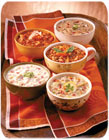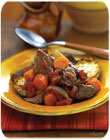French cooking techniques and influences are used in most of the meals prepared in Madagascar. For example, there is a popular Madagascar vegetable soup called lasopy, made from veal or beef broth, carrots, turnips, white potatoes, scallions, string beans, tomatoes and salt. All the ingredients are cooked until they are tender, then put through a sieve or pureed in a blender or food processor. The mixture becomes a thick soup that is eaten with crackers or freshly baked bread. There is a similar thick soup eaten throughout France called potage crecy (carrot soup) made of beef broth, butter, carrots, onions, white potatoes, marjoram, salt and pepper.

Romazava, with cubes of beef, pork and chicken, chopped onions, tomatoes, spinach and crushed garlic, is considered the national dish of Madagascar.
Another Madagascar dish is called akoho misy sakamalao (chicken with garlic and ginger) and is made from chicken, ginger, garlic, shallots or onions, cloves, salt, pepper and peanut or vegetable oil. The chicken is seasoned with ginger, garlic, shallots, cloves, salt and pepper, and sautéed in oil. It is then served with boiled okra or artichoke hearts. Its French counterpart is called poulet saute a la Bordelaise (sautéed chicken with shallots and artichoke hearts), and contains similar ingredients and is cooked the same way. Akoho misy sakamalao usually is served with some type of spicy condiment on the side such as sakay, made of crushed red peppers, ground ginger, crushed garlic and vegetable oil. This is mixed together and served in a small bowl or butter dish.
Romazava is considered the national dish of Madagascar, and each family makes their own version. It is a one-pot dish, usually eaten with rice for lunch or dinner. The basic ingredients are beef, pork and chicken cut into equal-size cubes, chopped onions, tomatoes, spinach and crushed garlic. The beef, pork and chicken cubes are seasoned with salt and pepper, then sautéed in a small amount of peanut or vegetable oil. The remaining ingredients are added and cooked until the meat and vegetables are tender.

Soups and stews remain a popular food among Americans. Manufacturers looking for new flavor ideas can garner some creative ideas from traditional dishes in Madagascar.
Beverages and Desserts
Rice is a staple in Madagascar, and is eaten at most meals. There is even a popular beverage called ranonapango, made from burned rice. After a pot of rice has been overcooked, boiling water is added to the burned rice grain to absorb its flavor. Then the water is poured off, chilled and served as a beverage with a meal.
Another popular beverage is ginger beer, made from freshly grated ginger, sugar, yeast and water. All ingredients are mixed together, poured into a container, covered and placed in the refrigerator or a cool place for two to three days to allow fermentation to take place. It is then filtered through cheesecloth and served over ice.
Unlike in France, desserts in Madagascar are prepared very simply. Fresh fruits such as lichee nuts, pineapples, cantaloupes, oranges, bananas or strawberries are sliced and sprinkled with vanilla bean (seeds). Often, some type of sweetened vanilla cream sauce is poured over the fruit slices.
Madagascar produces about two-thirds of the world's vanilla. The vanilla bean (or pod) is the only edible fruit-bearing orchid. Each flower opens only one day a year and must be hand-pollinated to produce a pod, which is very labor intensive. Madagascar vanilla has a creamy, sweet, velvety flavor that can be used to make dessert baked goods, ice creams, salad dressings and barbecue sauces.

Madagascar's climate is conducive to growing export products such as: coffee, vanilla, sugarcane, rice and bananas. The meat and seafood processing industries also are important in that country.
On the Mainland
The African pavilion at the Spring 2006 International Fancy Food & Confection Show, held in Chicago, featured 19 innovative manufacturers promoting their food and beverage products. According to the National Association of Specialty Food Trade, which hosted the show, there has been an increased interest and demand for unique and exotic food and beverage products over the past 10 years.
The African Pavilion had distinctly African teas such as South Africa's honey bush tea and rooibos tea (a.k.a. red tea) and black teas from Kenya, the fourth-largest black tea producer and exporter in the world. There were also African birdseye chile peppers (small, fiery hot chilies), spicy curry blends, chili sauces and chutneys, as well as honey products from Kenya and wines from South Africa.
One of the companies, Nali Ltd., based in Malawi, Africa, produces a line of nine pepper sauces, all made with birdseye chiles. Some unique pepper sauce flavors are Nali Ginger Africa's Peri-Peri Sauce, made of water, ginger, vinegar, birdseye chiles, paprika, onions, tomatoes, salt and pepper. Also produced is Nali Chicken Braai Africa's Peri-Peri Sauce, made of water, chicken barbecue flavor, vinegar, birdseye chiles, paprika, onions, salt and pepper.
Eswatini Swazi Kitchen, in Swaziland, Africa, produces 30 types of jams, marmalades, chutneys, atchars and hot sauces. Swaziland is bordered by Mozambique and South Africa. Eswatini Swai kitchen purchases its fruits and vegetables from 400 local rural farmers and growers. Some of its signature products are pineapple and mango jam, grapefruit marmalade, strawberry and chili chutney, and lime pickles.
Clearly, Madagascar has a rich and diverse culture that is reflected in its wide variety of culinary offerings. Perhaps American chefs and diners will be inspired by some of these unique combinations and add a bit of this exotic island flavor to their dining experiences.
Website Resources:
www.eswatinikitchen.co.sz — Website of Eswatini Swazi Kitchen
www.africa.upenn.edu/Cookbook/Madagascar.html — Malagasy customs, foods and recipes
www.recipes4us.co.uk/Cooking%20by%20Country/Madagascar.htm — More Malagasy recipes, and a bit of food history
